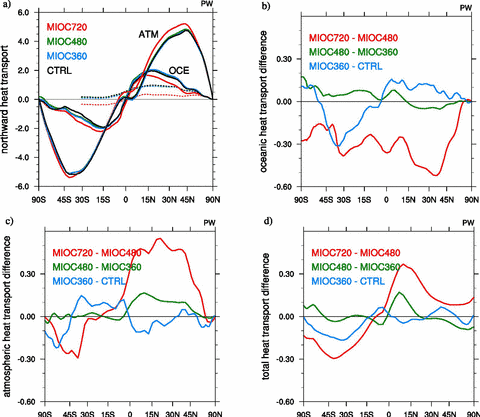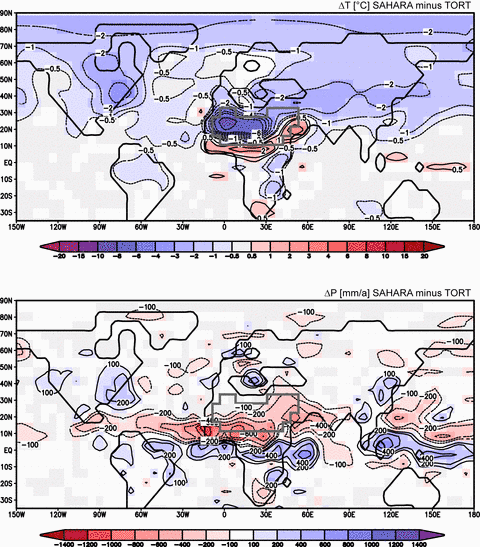Major results
- The climate during the Late Miocene and the Mid Miocene is warmer and more humid than today in agreement with the fossil record and marine proxy data.
- The meridional temperature gradient decreases with increased atmospheric CO2.
- Heat transport changes in the coupled atmosphere/ocean system nearly compensate each other (Fig. 2).
- Reduction of the gradient is mainly due to local changes in the mid and hig-latitudes owing to vegetation and ice-albedo changes.
- Regional vegetation changes such as the appearance of the Sahara desert are 'climatic global players' (Fig. 3).
- The fully coupled atmosphere/ocean system is more sensitive to Miocene boundary changes than idealized model approaches, comprising ocean and atmosphere/slab ocean models. This highlights the role of interactive atmosphere-ocean feedbacks within the coupled system and the importance of three-dimensional ocean changes on the thermal response.
- Warmer climates in the geological past can be reconciled with lower CO2 concentrations than today.

Figure 1: Differences in 2m air temperature between (a) MIOC360 and CTRL, (b) MIOC480 and MIOC360, and (c) between MIOC720 and MIOC480 (in K).

Figure 2: (a) Northward heat transport by atmosphere and ocean (in PW). Dashed lines correspond to heat transport by the Atlantic Ocean. Difference in the (b) oceanic heat transport, (c) the atmospheric heat transport, and (d) the total (atmosphere + ocean) heat transport. Note the different scale in the difference plots (b)-(d).

Figure 3: (a) The annual average temperature differences (°C), (b) the annual average precipitation rate differences (mm/a), and (c) the annual average evaporation rate differences (mm/a) between SAHARA and TORT. Non-coloured white areas represent non-significant differences with a Stuent's t-test (p = 0.05). The grey line illustrates the area of the modern Sahara desert. (For interpretation of the references to colour in this figure legend, the reader is referred to the web version of Micheels et al. (2009).
References
Butzin, M., Knorr, G., Bickert, T., Lohmann, G., 2011. Marine C cycle response in Miocene climate simulations. in preparation.
Eronen, J.T., Mirzaie, M., Karme, A., Micheels, A., Bernor, R.L., Fortelius, M., 2009. Distribution history and climatic controls of the Late Miocene Pikermian chronofauna. Proceedings of the National Academy of Sciences USA (PNAS), 106(29), 11867-11871.
Harzhauser, M., Piller, W.E., Müllegger, S., Grunert, P., Micheels, A., 2011. Changing seasonality patterns in Central Europe from Miocene Climate Optimum to Miocene Climate Transition deduced from the Crassostrea isotope archive. Global and Planetary Change, 76(1-2), 77-84.
Knorr, G., Butzin, M., Lohmann, G., Micheels, A., 2011b. The Impact of CO2 and dynamical vegetation changes on Miocene cooling, in preparation.
Knorr, G., M. Butzin, A. Micheels, and G. Lohmann (2011), A Warm Miocene Climate at Low Atmospheric CO2 levels, Geophys. Res. Lett., doi:10.1029/2011GL048873, in press.
Krapp, M. and Jungclaus, J. H.: The Middle Miocene climate as modelled in an atmosphere-ocean-biosphere model, Clim. Past Discuss., 7, 1935-1972, doi:10.5194/cpd-7-1935-2011, 2011.
Micheels, A., Bruch, A.A., Eronen, J., Fortelius, M., Harzhauser, M., Utescher, T., Mosbrugger, V., 2011. Analysis of heat transport mechanisms from a Late Miocene model experiment with a fully-coupled atmosphere-ocean general circulation model. Palaeogeography, Palaeoclimatology, Palaeoecology, 304(3-4), 337-350.
Micheels, A., Bruch, A.A., Mosbrugger, V., 2009b. Miocene climate modelling sensitivity experiments for different CO2 concentrations. Palaeontologia Electronica, 12(2), 6A, 20 p.
Micheels, A., Eronen, J., Mosbrugger, V., 2009a. The Late Miocene climate response to a modern Sahara desert. Global and Planetary Change, 67(3-4), 193-204.
Schneck, R., Micheels, A., Mosbrugger, V., 2011. Climate impact of the high northern vegetation - Late Miocene and present. International Journal of Earth Sciences, xxx(x-x),xx-xx.
Tang, H., Micheels, A., Eronen, J., Fortelius, M., 2011. Regional climate model experiments to investigate the Asian monsoon in the Late Miocene. Climate of the Past, 7, 847-868, doi:10.5194/cp-7-847-2011.


